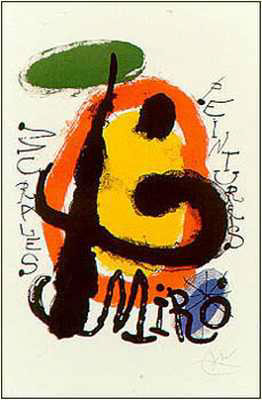Learn About Joan Miro in Art History, View His Art and Famous Paintings

"Peintures” Joan Miro,
Joan Miro,1893-1983, one of Spain’s famous artists in art history, was one of the greatest artists of the Surrealism period. One of his early famous paintings "Portrait of E. C. Richart", 1917 was influenced by Vincent van Gogh's painting "Pere Tanguy, 1887.
Two years later, influenced by Picasso and Matisse, Miro painted "Nude with a mirror" 1919. rendering areas of large flat color and cubist faceting. Experimenting further with his art style, Miro painted "The Farm" in 1921-1922, influenced by Catalan primitive church-paintings. He felt he had a need for discipline to simplify forms from nature as the Catalan primitives had done.
Influenced by contemporary French poets, Joan Miro produced art forms from his own hallucinations, "I would sit for long periods looking at the bare walls of my studio trying to capture these shapes on paper or burlap....",
 a method of automatism releasing the expressions of the unconscious mind from the control of the conscious mind.
a method of automatism releasing the expressions of the unconscious mind from the control of the conscious mind.
Joan Miro began to rely less on hallucinations for his art forms. He took ideas from visible nature when he painted another of his famous paintings"Catalan Landscape (The Hunter)" in 1923-24. It was a transition into fantasy painting, possibly influenced by Paul Klee, and Jean Arp. Even though Miro’s art forms were taken less from hallucinations, they were still far from being realistic, exampled by the moon, dog and ladder appearing in the painting "Dog Barking at the Moon", 1926.

In one of Miro's famous artworks in art history "Painting", 1933, he started preliminary work by tearing shapes from newspapers, and arranging them in a collage-like composition. The shapes were biometric, abstract, curvilinear, and geometric in nature. The assembled collages then acted as a point of departure and beginning stages for a painting. He then did not replicate the collage forms, but used them as a catalyst to spawn new ideas.
Joan Miro described his painting process as going in and out of consciousness, creating ideas and forms in both realms. He started the art process in a more unconscious state by letting his brush initiate forms on a canvas. As he continued, the brush would assert itself and suggest things. His conscious state would then take over and turn these suggestions into recognizable art forms. Once these forms were realized they would suggest other forms, which in turn demanded other forms, and then more forms to balance all of those forms.
Miro worked on more than one canvas at a time. As new inspirations motivated him he would switch to work on new paintings and would work on those artworks as far as the inspiration would carry him. He would not come back to the original unfinished artwork, sometimes for months.
In Joan Miro's famous paintings in art history three stages were always prevalent. "first, the suggestion, usually from the material; second, the conscious organization of these forms; and third the compositional enrichment". His first stage "is free, unconscious; but after that the picture is controlled throughout in keeping with that desire for disciplined work I have felt from the beginning”. Other famous artists from the Surrealism period are Salvador Dali and Giorgio Chirico.
To view the gallery of Joan Miro paintings click here.
Click on the graphics below to increase graphic sizes. At the same you time can also view an opportunity to purchase a poster or painting reproduction.
















|
